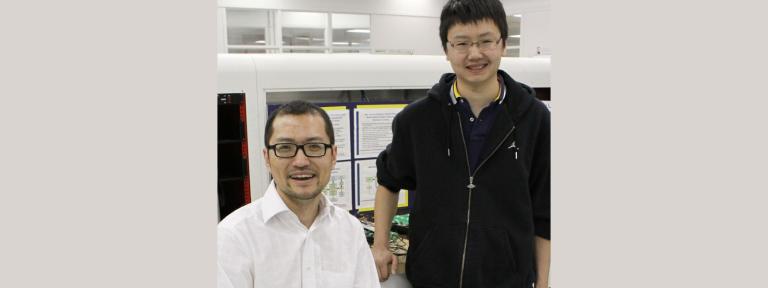
“A long time ago, we only used cell phones to make calls. But now, most people use their phone as an entire system. We want to apply that idea to the charger. It will potentially have a big impact on society.”
When Nelson Wang ‘12 was in need of a lab and research collaborators to develop a prototype of his company’s state-of-the-art Electric Vehicle charging technology, he found them in a familiar place -- the Advanced Power Electronics Lab (APEL) at Kettering University.
Wang -- currently a Ph.D. candidate in Electrical Engineering at the Massachusetts Institute of Technology (MIT) -- co-founded his company, CZAR (Carbon Zero Advanced Research) Power, in 2014. The company is currently developing charging technology that is bidirectional in power flow and accepts inputs from solar power to charge EVs or other battery systems without fossil fuels.
“We’re developing a charger for electric vehicles, but the key differentiation from existing charging technology is we’re trying to make it ‘smart,’” Wang said. “No one else has a charger like what we’re developing. We think of it differently -- we want it to be communicating with renewable energy sources, like solar.”
Wang worked for Dr. Kevin Bai, associate professor of Electrical Engineering, in the Advanced Power Electronics Lab for his co-op position as an undergraduate at Kettering. It was during that experience in 2011 that the idea for this technology was initially discussed.
“Kevin was my undergrad supervisor,” Wang said. “We always discussed ideas, we participated in competitions and won awards. We started to think then about how we could do something for the real world.”
That undergraduate experience also showed Wang the immense capabilities of the lab and the researchers working with Bai.
“Professor Bai is very smart and has a lot of experience in these types of research prototypes,” Wang said. “I have worked with him on several before this and enjoy working with him. His team over past six months has been very hard working and we have seen exciting progress from them.”
The project with Kettering began in March. The technology would enable the charger to be capable of interacting with solar power sources, storing energy and serving as a ‘hub’ that connects several elements in the renewable energy world -- the battery, the storage system and the traditional utility.
“It will form a small micro-grid system,” Wang said.
The research team has patents on some of the new technology, which differentiates it from other chargers currently on the market. Bai and his team in APEL have done work on hardware as well as performed temperature and safety tests. Wang’s MIT collaborators have worked on software, including communication and controls for a smart grid system.
“We’ve already fully tested the system and it works very well,” Bai said. “Our team is working to help find more efficiency and increase power density for the charging station.”
Some of the initial tests have been promising, including showing approximately 96 percent efficiency. Researchers are also working to connect the charging station to the internet, so drivers would be able to obtain location information of the charging station through their phone. They’d be able to monitor the usage of solar energy generated vs. energy used from the grid and calculate the real cost for electricity used.
“A long time ago, we only used cell phones to make calls,” Wang said. “But now, most people use their phone as an entire system. We want to apply that idea to the charger. It will potentially have a big impact on society.”
Once completed, the market for this type of charger is large, particularly in foreign countries where the proliferation of electric vehicles is greater. CZAR Power has had investors and interest from companies in Japan and China. There’s also potential to get the technology into the U.S. market if testing continues to go well.
“Once successful, this technology will allow renewable energy to be connected to infrastructure, thereby charging vehicles more economically,” Bai said. “It will promote future microgrid development, resulting in a less centralized grid. So, for example, if a blackout happens, this charging technology would allow a house or vehicle to still have access to power.”
The project is also a good illustration of the impact Kettering’s education model has on graduates.
“Nelson has worked with me on industry projects before, which is the reason he came back to us for further collaboration,” Bai said. “That’s very good evidence that his previous research experience benefitted his career development. He came back to work with us closely because his previous projects gave him confidence that our lab could prototype something quickly and effectively. It’s also a very obvious and significant case of entrepreneurship -- our students and alumni want to earn degrees, but many also want to develop their own products, technologies and companies and Nelson is doing that.”
Wang has been able to combine his undergraduate and graduate research and education with his passion for creating a positive impact on society. Now, through this project, he’s learning how to take a potentially world-changing idea and turn it into a viable product and technology.
“I worked on EV charger projects approximately five years ago at Kettering, and was very interested in those projects,” Wang said. “At MIT, I started working on a smart grid project and really started thinking -- how can we combine the electric car into a smart grid system? Now, I’m learning about business and how to commercialize my electrical engineering background to benefit society. That is my passion.”